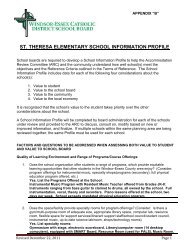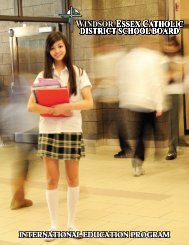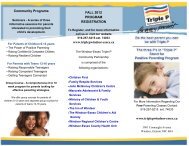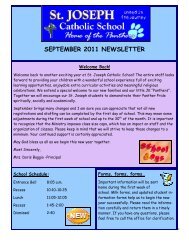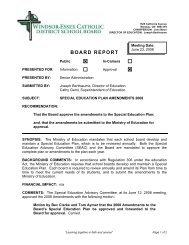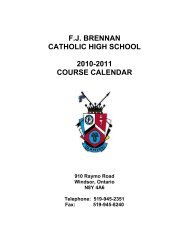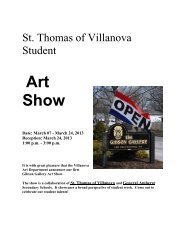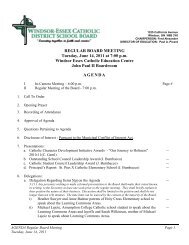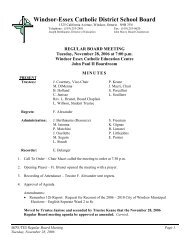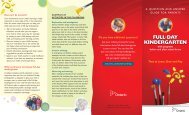Secondary School Student Planning Guide - Windsor-Essex ...
Secondary School Student Planning Guide - Windsor-Essex ...
Secondary School Student Planning Guide - Windsor-Essex ...
Create successful ePaper yourself
Turn your PDF publications into a flip-book with our unique Google optimized e-Paper software.
The Ontario secondary school program is designed to equip all students with the knowledge and skills they need for successful outcomes – smooth<br />
transitions to the post secondary destinations of their choice: apprenticeship, college, community living, university, or the workplace. Our schools offer<br />
an education program in a safe and secure environment that promotes a high standard of achievement and provides all students with the learning opportunities<br />
and support they need. <strong>Secondary</strong> schools of the <strong>Windsor</strong>-<strong>Essex</strong> Catholic District <strong>School</strong> Board provide courses, programs, supports and<br />
experiences that are relevant to students’ interests and needs and to society’s needs and expectations.<br />
Courses in the curriculum have been organized to provide clear educational paths for students to select appropriate courses. The provision of<br />
different types of courses leading to specific destinations allows students to acquire a solid core of theoretical and applied learning and to focus learning<br />
on goals that have relevance for them.<br />
These courses are designed to<br />
provide students with a broad<br />
educational base that will prepare<br />
them for their studies in Grade 11<br />
and 12 and for productive<br />
participation in society.<br />
These courses allow<br />
students to broaden their<br />
knowledge and skills in a<br />
particular subject that may<br />
or may not be directly<br />
related to postsecondary<br />
goals. These courses are<br />
appropriate for all students<br />
regardless of postsecondary<br />
destination.<br />
The first 3<br />
characters refer<br />
to the Subject<br />
and Course<br />
These courses focus on the<br />
knowledge and skills that students<br />
need to be well prepared for<br />
success in Grade 11 Workplace<br />
Preparation courses. These<br />
courses focus on developing and<br />
enhancing strategies needed for<br />
better literacy and numeracy skills.<br />
These courses are<br />
designed to equip students<br />
with the knowledge and<br />
skills for direct entry into the<br />
workplace or for admission<br />
to some apprenticeship<br />
programs. The range and<br />
content of the courses allow<br />
students to prepare for a<br />
variety of jobs, training<br />
programs and careers.<br />
These courses emphasize<br />
workplace applications of<br />
the course content.<br />
The fourth character<br />
refer to the Grade Level<br />
1 = Grade 9<br />
2 = Grade 10<br />
3 = Grade 11<br />
4 = Grade 12<br />
Grade Nine and Ten Courses<br />
College preparation courses<br />
are designed to equip<br />
students with the knowledge<br />
and skills to meet the<br />
entrance requirements for<br />
college programs. These<br />
courses emphasize concrete<br />
applications of the material<br />
covered in the course and<br />
emphasize the development<br />
of critical thinking and<br />
problem solving skills.<br />
Applied courses develop<br />
students’ knowledge and skills by<br />
emphasizing practical, concrete<br />
applications of concepts and<br />
incorporating theoretical applications<br />
as appropriate.<br />
Grade Eleven and Twelve Courses<br />
Course Coding<br />
These courses are<br />
designed to equip students<br />
with the knowledge and<br />
skills to meet the<br />
entrance requirements for<br />
specific university and<br />
college programs. Teaching<br />
and learning emphasize<br />
both theoretical aspects<br />
and related concrete<br />
applications.<br />
The fifth character refers to the of course:<br />
C = College<br />
M = University / College<br />
D = Academic<br />
P = Applied<br />
E = Workplace<br />
O = Open<br />
L = Locally Developed U = University<br />
Academic courses develop<br />
students’ knowledge and skills by<br />
emphasizing theoretical, abstract<br />
applications of the essential<br />
concepts and incorporating practical<br />
applications as appropriate.<br />
These courses equip<br />
students with the knowledge<br />
and skills to meet<br />
the entrance requirements<br />
for university programs.<br />
Teaching and learning<br />
emphasizes theoretical<br />
aspects of the course<br />
content as well as concrete<br />
applications.<br />
The sixth character is<br />
assigned by the board.<br />
Contact the guidance<br />
department for further<br />
information.<br />
<strong>Secondary</strong> <strong>School</strong> Credits<br />
A credit is granted in recognition of the successful completion (that is, completion with a final percentage mark of 50 per cent or higher) of a course that<br />
has been scheduled for a minimum of 110 hours. Credits are granted by a principal on behalf of the Minister of Education for courses that have been<br />
developed or authorized by the ministry. A half-credit may be granted for each 55-hour part of a 110-hour ministry-developed course in accordance with<br />
the policy outlined in the curriculum policy documents. Most courses are offered as single-credit courses. Some courses, such as technological<br />
education, interdisciplinary studies, and cooperative education courses, may be offered as multiple-credit courses.<br />
Specialist High Skills Major (SHSM):<br />
<strong>School</strong>s are providing students with more opportunities to customize their high school experience and build on their strengths and interests<br />
through a variety of new and enhanced learning options. One of those options is the Specialist High Skills Major (SHSM). A SHSM is a<br />
Ministry-approved specialized career-focused program that allows student to acquire knowledge and skills that are of particular importance in<br />
specific economic sectors and earn certifications recognized in those sectors, as they work towards meeting the requirements for an OSSD. A<br />
SHSM enables students to gain sector-specific skills and knowledge in the context of engaging, career-related learning environments and helps<br />
them focus on graduation and on pursuing their postsecondary goals. WECDSB currently offers SHSM programs in 7 high schools as follows:<br />
Agriculture: Cardinal Carter Catholic <strong>Secondary</strong> <strong>School</strong><br />
Arts & Culture: F. J. Brennan Catholic High <strong>School</strong> and St. Joseph's Catholic High <strong>School</strong><br />
Business: Holy Names Catholic High <strong>School</strong><br />
Construction: Cardinal Carter Catholic <strong>Secondary</strong> <strong>School</strong><br />
Energy: St. Anne Catholic High <strong>School</strong><br />
Environment: St. Anne Catholic High <strong>School</strong><br />
Health & Wellness: St. Joseph's Catholic High <strong>School</strong><br />
Hospitality & Tourism: Assumption College Catholic High <strong>School</strong><br />
Information & Communications Technology:St. Anne Catholic High <strong>School</strong> and St. Thomas of Villanova Catholic <strong>Secondary</strong> <strong>School</strong><br />
Sports: F. J. Brennan Catholic High <strong>School</strong><br />
For more information about any of these programs consult individual school course calendars or visit www.wecdsb.on.ca<br />
Specialized Programs:<br />
Specialized programs are programs that provide students with a particular curriculum focus to assist them in meeting diploma requirements and<br />
in making the transition to post secondary destinations (i.e. apprenticeship programs, college, university, and the workplace). Specialized<br />
programs may offer a comprehensive and integrated set of courses, supports and experiences that may be spread over a number of semesters<br />
or years and may result in a specialized diploma. The Board offers specialized programming at specific schools including:<br />
• French Immersion (Cardinal Carter, St. Anne, St. Joseph’s, St. Thomas of Villanova)<br />
• English Language Learners (Cardinal Carter, Catholic Central)<br />
• International Baccalaureate Programme (Assumption College High <strong>School</strong>)<br />
• International Education: WECDSB is connecting students all over the world through our International Education Program.<br />
<strong>Student</strong>s gain first-hand experience of other cultures in a world that is becoming increasingly globalized. Through international<br />
education, students are able to gain an understanding of how others view our world and in turn develop a greater appreciation<br />
of their place in it.<br />
For more information about any of these programs consult individual school course calendars and/or contact the specific school.<br />
Changing Pathways:<br />
<strong>Student</strong>s are not locked into a specific pathway during their high school experience. Various mechanisms facilitate the change from one course<br />
type or program pathway to another should students’ goals or interests change. Consult your Guidance Dept. for more information.<br />
Course Selection Change:<br />
Parents and students should be aware that courses are offered and student timetables are constructed based on initial course selections. Careful<br />
consideration should be given to these selections. Course changes may be made in consultation with guidance counsellors at appropriate times,<br />
provided space is available in the alternative courses.<br />
Policy on Substitution for Compulsory Credits:<br />
Substitutions may be made for a limited number of compulsory credits. To meet individual students’ needs, the principal may replace up to three<br />
compulsory credits. The decision to make a substitution is made in consultation with parents and appropriate school staff. Each substitution will<br />
be noted on the student’s Ontario <strong>Student</strong> Transcript.<br />
Procedures for <strong>Student</strong>s Who Fail or Do Not Complete Courses:<br />
The principal and teaching staff, in collaboration with the student and/or parent(s), will determine the procedure or type of program will best enable<br />
the student to meet the curriculum expectations and earn credit for the course. Repeating the entire course during the school year or upgrading<br />
during Summer <strong>School</strong> are common means to recover a credit. Credit Rescue and Credit Recovery programs may be accessed through your<br />
<strong>School</strong> Success Team. Contact your <strong>Student</strong> Success teacher for more information.<br />
<strong>Student</strong>s may earn an Ontario <strong>Secondary</strong> <strong>School</strong> Diploma, an Ontario <strong>Secondary</strong> <strong>School</strong> Certificate or a Certificate of Accomplishment.<br />
The Ontario <strong>Secondary</strong> <strong>School</strong> Diploma (OSSD)<br />
In order to earn an Ontario <strong>Secondary</strong> <strong>School</strong> Diploma, a student must complete:<br />
Plus<br />
Plus<br />
Plus<br />
<strong>Student</strong>s must earn the following compulsory credits to obtain the Ontario <strong>Secondary</strong> <strong>School</strong> Diploma:<br />
4 credits in English (1 credit per grade)*<br />
3 credits in mathematics (at least 1 credit in Grade 11 or 12)<br />
2 credits in science<br />
1 credit in Canadian history<br />
1 credit in Canadian geography<br />
1<br />
1<br />
1<br />
18 compulsory credits<br />
Plus one credit from each of the following groups:<br />
Community<br />
Involvement Requirement<br />
<strong>Student</strong>s must complete a minimum of 40 hours of<br />
community involvement activities during their years in the<br />
secondary school program. This requirement is completed<br />
outside normal instructional hours in a variety of settings.<br />
<strong>Student</strong>s may not fulfill this requirement through activities<br />
that are counted towards a credit, through paid work, or by<br />
assuming duties normally performed by a paid employee.<br />
For more information, visit www.wecdsb.on.ca and follow<br />
the links under Programs.<br />
1 credit in the arts<br />
1 credit in health and physical education<br />
1 credit in French as a second language<br />
0.5 credit in career studies<br />
0.5 credit in civics<br />
group 1: additional credit in English, or French as a second language**, or a Native language, or a classical<br />
or international language, or social sciences and the humanities, or Canadian and world studies, or guidance<br />
and career education, or cooperative education***<br />
group 2: additional credit in health and physical education, or the arts, or business studies, or French as a second<br />
language**, or cooperative education***<br />
group 3: additional credit in science (Grade 11 or 12), or technological education, or French as a second language**,<br />
or computer studies, or cooperative education***<br />
In addition to the compulsory credits, students must complete:<br />
12 optional credits †<br />
40 hours of community involvement activities<br />
the provincial literacy requirement<br />
*A maximum of 3 credits in English as a second language (ESL) or English literacy development (ELD) may be counted<br />
towards the 4 compulsory credits in English, but the fourth must be a credit earned for a Grade 12 compulsory English<br />
course. **In groups 1, 2, and 3, a maximum of 2 credits in French as a second language can count as compulsory credits,<br />
one from group 1 and one from either group 2 or group 3. ***A maximum of 2 credits in cooperative education can count as<br />
compulsory credits. †The 12 optional credits may include up to 4 credits earned through approved dual credit courses.<br />
<strong>Secondary</strong> <strong>School</strong><br />
Literacy Graduation Requirement<br />
The purpose of the Ontario <strong>Secondary</strong> <strong>School</strong> Literacy Test (OSSLT) is<br />
to ensure that students have acquired the essential reading and writing skills<br />
that apply to all subject areas in the provincial curriculum up to the end of<br />
Grade 9. <strong>Student</strong>s who are working toward an Ontario <strong>Secondary</strong> <strong>School</strong><br />
Diploma are required to write the OSSLT in Grade 10. <strong>Student</strong>s who have<br />
attempted the OSSLT at least once have been unsuccessful are eligible to<br />
fulfill the requirement through the Ontario <strong>Secondary</strong> <strong>School</strong> Literacy<br />
Course (OSSLC). Successful completion of the OSSLT or OSSLC is a<br />
graduation requirement. For more information, visit the EQAO website,<br />
www.eqao.com.<br />
<strong>Student</strong>s who successfully complete a Specialist High Skills Major (SHSM) program as part of the requirements for their OSSD will receive a<br />
diploma with an SHSM red seal.<br />
The Ontario Scholar Program<br />
The Ontario Scholar Program recognizes students who have earned an Ontario <strong>Secondary</strong> <strong>School</strong> Diploma in the current or previous school year<br />
and who have attained an aggregate of at least 480 marks in any combination of ministry approved courses that provide a total of 6 credits. Upon<br />
the recommendation of their principal, these graduating students receive a certificate from the Minister of Education.<br />
The Ontario <strong>Secondary</strong> <strong>School</strong> Certificate (OSSC)<br />
The Ontario <strong>Secondary</strong> <strong>School</strong> Certificate will be granted on requested to students who leave school before earning the Ontario<br />
<strong>Secondary</strong> Diploma, provided that they have earned a minimum of 14 credits distributed as follows:<br />
• Compulsory credits (total of 7)<br />
2 credits in English 1 credit in science<br />
1 credit in Canadian geography or Canadian history 1 credit in health and physical education<br />
1 credit in mathematics 1 credit in the arts or technological education<br />
• Optional credits (total of 7)<br />
The Certificate of Accomplishment<br />
<strong>Student</strong>s who are leaving secondary school upon reaching the age of eighteen without having met the requirements for the Ontario <strong>Secondary</strong><br />
<strong>School</strong> Diploma or the Ontario <strong>Secondary</strong> <strong>School</strong> Certificate may be granted a Certificate of Accomplishment. The Certificate of Accomplishment<br />
may be a useful means of recognizing achievement for students who plan to take certain kinds of further training, or who plan to find employment<br />
directly after leaving school. The Certificate of Accomplishment is to be accompanied by the student’s Ontario <strong>Student</strong> Transcript.<br />
<strong>School</strong>s are offering more opportunities to customize your high school experience and build on your strengths and interests through a variety of new and enhance learning<br />
options including Experiential Learning. Experiential Learning programs enhance your academic background and provide you with opportunities to gain valuable<br />
experiences in our community. No matter your post secondary pathway, experiential learning can assist you in making career decisions and help you develop the knowledge,<br />
skills and habits required in the workplace. All forms of experiential learning are a valuable complement to your post secondary preparation and future employment.<br />
Experience /<br />
Program<br />
Length<br />
Eligibility /<br />
Delivery<br />
e-Learning is:<br />
• A pathway for a student to earn a high school credit independently<br />
• Available via the internet from anywhere in the world<br />
• Taught by an accredited teacher assigned to the course to guide and support student progress<br />
throughout the course.<br />
E-Learning Ontario (e-LO) is an essential online resource for the Ontario-funded school system, providing<br />
elementary and secondary teachers and learners with the flexibility they need to reach their goals. Through e-LO, the Ministry of Education offers<br />
participating school boards new ways to teach Ontario's curriculum and help their students succeed. In this winning partnership, school boards retain<br />
full responsibility for the delivery of courses and resources at the local level and e-LO provides leadership, software tools, and guiding policies.<br />
On-line learning provides a different learning experience for students. On-line learning:<br />
• Allows students to learn in a more independent and flexible environment<br />
• Allows access to courses unavailable in your school<br />
• Allows students to get experience with a popular college / university course delivery format<br />
• Increases student’s technology skill set for future learning<br />
• Assists students in developing the skills needed for the 21st century<br />
In the 2012-2013 academic school year, we will be offering the following on-line courses Semester<br />
2 to our Grade 11 & Grade 12 students. All courses are subject to student enrolment requirements.<br />
HRT3MV World Religions, Gr. 11, University/College Prep<br />
CGW4UV Canadian & World Issues: A Geographic Analysis, Gr. 12, University Prep<br />
EMS3OV English Media Studies, Gr.12, Open<br />
ENG4UV English, Gr. 12, University Prep<br />
EWC4UV Writer’s Craft, Gr. 12, University Prep<br />
HSB4MV Challenge & Change in Society, Gr. 12, University/College Prep<br />
SPH4UV Physics, Gr. 12, University Prep<br />
The sixth character (V) in each course codes indicates that the course is an on-line, e-Learning course.<br />
Your first step in registering for an on-line course is to consult your guidance counsellor<br />
for further information or visit www.wecdsb.on.ca<br />
Guidance<br />
Guidance Counsellors work to foster the total development of<br />
students in conjunction with administration, staff, parents and<br />
community agencies. With the assistance of qualified<br />
counsellors, students explore a broad range of opportunities to<br />
support student development, interpersonal development and<br />
career development. Counsellors assist students in developing<br />
learning skills and strategies that can be used in secondary and<br />
post-secondary opportunities.<br />
Campus Ministry<br />
Credits<br />
Job Shadowing ½ to 1 day Any grade N/A<br />
Job Twinning ½ to 1 day Any grade N/A<br />
Work Experience 1 – 4 weeks Any grade N/A<br />
Co-operative<br />
Education<br />
Program<br />
(Co-op)<br />
Ontario Youth<br />
Apprenticeship<br />
Program<br />
(OYAP)<br />
<strong>School</strong>-Work<br />
Co-op<br />
Program<br />
1 semester or<br />
more<br />
usually 0.5 day<br />
1, 2, 3 or 4<br />
credit<br />
scheduling<br />
options<br />
Summer Co-op<br />
also available<br />
1 or 2 year<br />
program in<br />
senior years<br />
1 or 2 year<br />
program in<br />
senior years<br />
Grade 11<br />
Grade 12<br />
Prerequisite<br />
1 related<br />
Technology<br />
course<br />
Must be 16 years<br />
of age<br />
Must have 16<br />
credits<br />
Grade 11<br />
Grade 12<br />
Grade 11<br />
Grade 12<br />
2<br />
or<br />
more<br />
2<br />
or<br />
more<br />
2<br />
or<br />
more<br />
Campus Ministers are adult leaders who organize and assist with<br />
visible faith events in every Catholic high school. While all staff<br />
members are called to model the example of Jesus Christ,<br />
Campus Ministers are commissioned to promote activities and<br />
events that give witness to the life of the Church in a school setting.<br />
Sacramental services such as the Mass, Reconciliation and<br />
Liturgies of the Word are some of the visible signs and grace-filled<br />
opportunities for students in Catholic high schools to deepen their<br />
spiritual lives. Grade-level Retreats, Peer Ministry, Church season<br />
celebrations, social justice events, inclusive gatherings and<br />
organized supports for individual and community causes are some<br />
of the activities in the midst of which, you will find a Campus<br />
Minister.<br />
Co-Curricular Activities<br />
All of the Board’s High <strong>School</strong>s offer excellent Co-Curricular<br />
programs to meet the needs and interests of the students. These<br />
programs are intended to enrich the education of the students.<br />
<strong>Student</strong>s can choose to participate in a variety of sports teams,<br />
activities and clubs. Involvement in these activities provides<br />
students with valuable experiences which continue to benefit them<br />
beyond their high school years.<br />
Description<br />
• One-on-one observation of a worker at a place of employment<br />
• Take Our Kids to Work Day in Grade 9 is prototype of job shadowing<br />
• May be incorporated into any credit course<br />
• Counts towards the Experiential Learning component requirement for an SHSM<br />
• One-on-one observation of a cooperative education student at his or her placement<br />
• May be incorporated into any credit course<br />
• Counts towards the Experiential Learning component requirement for an SHSM<br />
• A planned learning opportunity that provides students with a relatively short-term work<br />
experience<br />
• May be incorporated into any credit course<br />
• Counts towards the Experiential Learning component required for an SHSM<br />
• A ministry-approved program that allows students to earn secondary school credits while<br />
completing a work placement in any career field<br />
• <strong>Student</strong>s can apply 2 co-op credits towards their compulsory high school graduation<br />
requirements with not limit on earning potential co-op credits<br />
• “Test-drive” career options and gain valuable work experience for postsecondary programs<br />
and future employment<br />
• 2 credits in co-op are required for an SHSM<br />
• Gain on-the-job training and experience in an apprenticeship in a skilled trade while earning<br />
credits towards the Ontario <strong>Secondary</strong> <strong>School</strong> Diploma (OSSD)<br />
• Accumulate workplace hours that count towards both secondary school co-op credits and<br />
the requirements of an apprenticeship program<br />
• May have an opportunity to receive Level 1 apprenticeship in-school training or be eligible<br />
to write an exemption test for Level 1<br />
• If enrolled in a ministry-approved dual credit program, may earn optional credits towards<br />
their OSSD for Level 1 apprenticeship in-school training<br />
• May involve the student’s registration in an apprenticeship<br />
• Apprenticeship opportunities are determined by the demand of local employers in 4<br />
sectors: industrial, motive power, service and construction<br />
• Sample occupations included Automotive Service Technician, Truck and Coach<br />
Technician, Cook, Hairstylist, Horticulturist, Carpenter, and General Machinist<br />
• A student may participate in OYAP as part of an SHSM program<br />
• For students who are planning to enter the workplace after graduation<br />
• Any area of work NOT requiring formal post-secondary education<br />
• A student may participate in <strong>School</strong>-Work Co-op as part of an SHSM program<br />
For further information or to apply to any of these programs, contact your Guidance Counsellor or school’s Co-op teacher<br />
<strong>Student</strong> Success<br />
Every secondary school has a <strong>Student</strong> Success team and a<br />
<strong>Student</strong> Success teacher to work in collaboration with school staff<br />
to support students who are struggling with their secondary school<br />
program and are at risk of not graduating. The <strong>Student</strong> Success<br />
team will include, at a minimum, the <strong>Student</strong> Success teacher and<br />
representation from administration, guidance, and special<br />
education.<br />
The responsibilities of the <strong>Student</strong> Success team for students<br />
considered to be at risk in secondary school include:<br />
• monitoring and tracking individual students’ progress;<br />
• providing direct support and/or instruction to improve their<br />
achievement, promote their retention, and support significant<br />
transitions;<br />
• supporting them in their education and career pathways<br />
planning;<br />
• supporting school-wide efforts to improve outcomes<br />
for students struggling with their secondary school program;<br />
• re-engaging early school leavers;<br />
• working with parents and the community to support<br />
student success.<br />
Special Education<br />
Post <strong>Secondary</strong><br />
Pathway<br />
Apprenticeship<br />
College<br />
University<br />
Work<br />
Apprenticeship<br />
College<br />
University<br />
Work<br />
Apprenticeship<br />
College<br />
University<br />
Work<br />
Apprenticeship<br />
College<br />
University<br />
Work<br />
Apprenticeship<br />
College<br />
Work<br />
“Blended Learning”, or b-Learning, is<br />
being piloted across the WECDSB during<br />
the 2011-2012 school year. Classroom<br />
teachers now have access to all of the<br />
tools of the Learning Management<br />
System (LMS) provided by e-LO.<br />
<strong>Student</strong>s in Grade 7-12 will have the<br />
opportunity to experience learning in an<br />
online environment as teachers combine<br />
traditional face-to-face instruction with<br />
online instruction. Features include class<br />
news, an online discussion board, a<br />
virtual dropbox to submit and assess<br />
student work, and e-portfolio, where<br />
students can tell their story and<br />
showcase their achievements with<br />
images, videos, and more.<br />
Teachers in the Special Education Department, in consultation with<br />
school personnel, parent/guardians, and community agencies,<br />
work together to address the programming needs of students with<br />
special needs. Educational support is provided through resource<br />
withdrawal, resource assistance or the Life Skills Program. By<br />
providing a wide range of services to best accommodate the needs<br />
of students, independence and responsibility for life-long learning<br />
is fostered. For further information refer to www.wecdsb.on.ca and<br />
the secondary school Special Education Department




